BUSSELTON AIRFIELD
RAAF STATION BUSSELTON
BUSSELTON, WA
IN AUSTRALIA DURING WWII
![]()
A fortnight after war broke out in September 1939 the South Western News announced that 300ha of the historic Fairlawn property on Commonage Road (renamed Queen Elizabeth Avenue after the 1954 Royal visit) had been acquired for the purpose of establishing RAAF Station Busselton.
Air Board Agenda 3390 of 1941 proposed the establishment of an Operational Station at Busselton in Western Australia in line with the decision to expand the Home Defence Units from 19 to 32 RAAF Squadrons. The Station was to comprise one General Reconnaissance Squadron with accommodation for 41 officers, 72 sergeants and above and 335 corporals and below, including all sleeping, messing, ablution, latrine and recreational facilities. Provision was to be made for splinter resisting hangerage for 18 aircraft, administrative and workshop facilities, W/T Transmission building, bomb dumps, and all engineering services.
There are files in NAA covering splinter proof hangars, splinter proof pens, and splinter proof workshops. Another file covers the installation of six machine gun explacements.
The Station was to be established at the site of the existing Civil Aerodrome and required the acquisition of additional land, approximately 26 acres for extensions to the airfield and approximately 25 acres for the W/T Transmission building site. The proposed development was approved by the Air Board on 16 August 1941.
On 10 January 1942, the Air Board approved work to camouflage buildings at Busselton Airfield for an estimated cost of £3,660.
It was originally thought that the Busselton Airfield would meet all RAAF requirements without the need to construct hard-surfaced runways. However recent experience in late 1941, early 1942 was that during the winter of 1941 large areas of the airfield were continuously so wet as to constitute a danger to flying. The water covered the surface to a depth of several inches in some places, and at other places the ground was waterlogged and soft.
Consideration was given to the possibility of improving conditions by grading and filling, but in view of the very flat nature of the ground and the fact that the spreading of filling would destroy the existing grass cover, that method was discarded in favour of constructing hard-surfaced runways.
On 28 February 1942, the Air Board approved that the north-south and east-west runways at RAAF Station Busselton be constructed in gravel at a total estimated cost of £33,120.
No. 4 Recruit Depot RAAF was the main lodger unit at RAAF Station Busselton and it provided administrative and logistical support to No. 33 Radar Station RAAF at Cape Naturaliste. There was a Meteorological Office located at the airfield.
Item ID 3210079 in NAA covers "Annual Inspection of Ammunition and Explosives - Advanced Operation Base Busselton."
The following NAA Files cover an Air to Ground Gunnery Range located in the area:-
Item ID 3277072 - "DWB (Director of Works and Buildings) - Property - Busselton - Air-to-ground gunnery range - Hiring of site"
Item ID 3277073 - "DWB (Director of Works and Buildings) - RAAF Busselton WA - Air-to-ground gunnery range - Wonnerup - Proclamation of danger area."
Item ID 3277074 - " "DWB (Director of Works and Buildings) - RAAF Station Busselton WA - Practice Bombing Range - Vasse Estuary - Declaration of danger area."
The "RAAF Aerodrome Guide Australia and Adjacent Islands" - RAAF Publication No. 694, dated January 1946, shows the following details for Busselton Airfield:-
| Class | RAAF Airfield |
| Position | 33 40 S, 115 20 E |
| Altitude | 20 feet |
| Dimensions | 4,500 feet, 4,500 feet |
| Direction | 004º, 094º |
| Surface | Both sealed |
| Remarks | Trees to 40' high surrounding. Water tower (30') West side N-S runway. Mast (150') to West. Flares - 1 hour. Accommodation. Fuel. HF/DF. Homer. QGH approach. Busselton township 2 miles North East. |
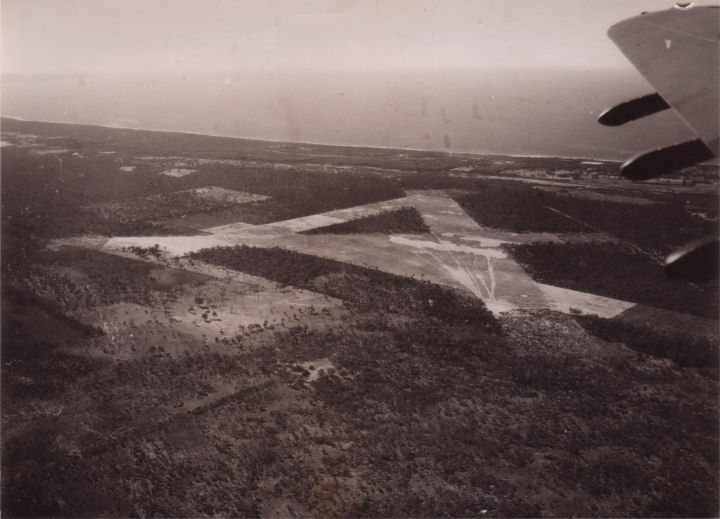
Photo:- 14 Squadron photo via Barry J. Goodall
Early aerial photo of Busselton Airfield
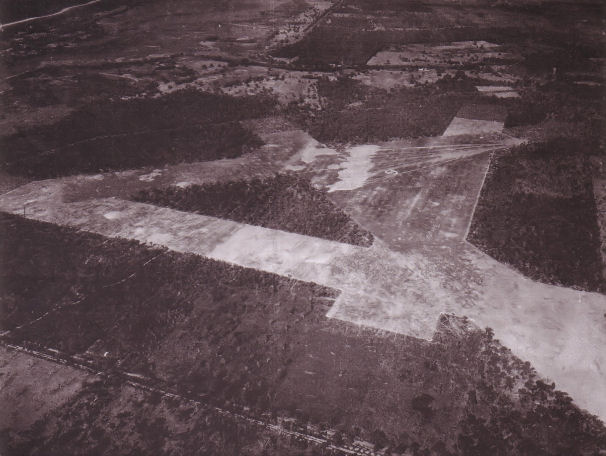
Photo:- via Tim Blue
Another early aerial photo of Busselton Airfield

Photo:- via Tim Blue
RAAF buildings at Busselton Airfield
The late Lindsay Peet, a respected military researcher in Western Australia, provided me with the following information:-
Local farmer Vern Dawson was only a lad but he distinctly remembers the military flavour of Busselton during the war years.
"I remember the planes would buzz our house and you could see the crew laughing and waving." he said. "But as a little bush kid, I was somewhat awed by the things."
"There were big dances at the Vasse hall with lots of air force people. They used to raise funds for the war effort by going around the hall with a blanket. People would throw money into it and they raised thousands of pounds."
A dummy hangar and dummy aircraft made of canvas and wood were built near the runways to give the impression that the base was well equipped to defend itself though the only arms available were .303 rifles and some Bren guns and Thompson sub-machine guns.
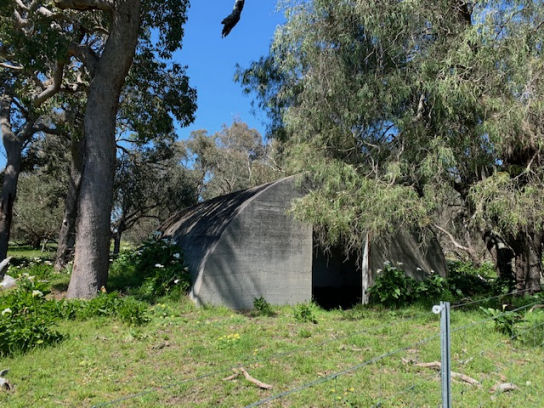
Photo:- Michael Whitbread
This bunker is located south of
the Busselton Airfield.
Does anyone know what it was used for? Some
have suggested it was an ammunition bunker?

Photo:- Michael Whitbread
Entrance to the above bunker
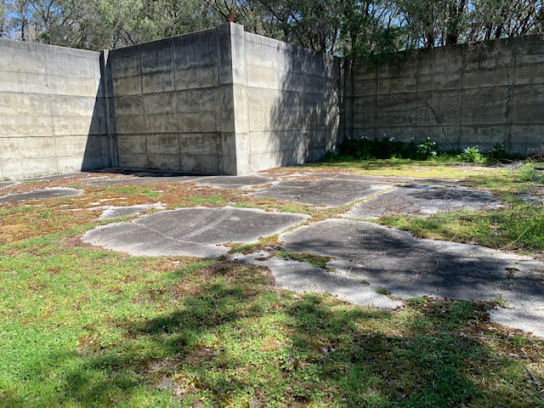
Photo:- Michael Whitbread
Splinter proof hangar south of Busselton Airfield
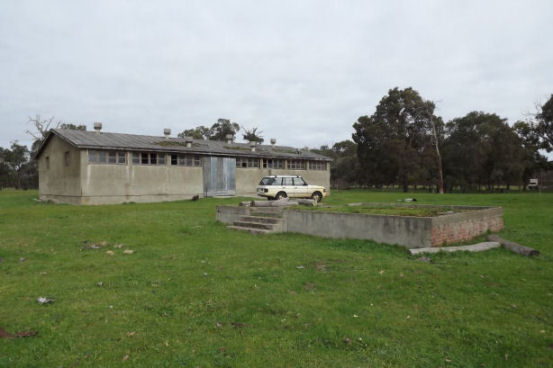
Photo:- Pamela Harrison via Tim Blue
Engineering workshop and another building foundation
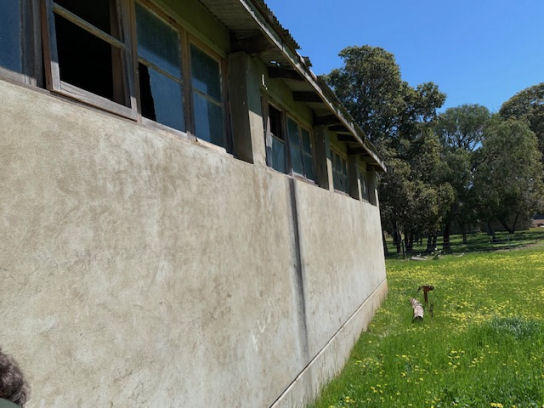
Photo:- Michael Whitbread
Northern side of workshop building
Photo:- Michael WhitbreadInside of northern wall of the workshop building
Photo:- Michael WhitbreadCross section of workshop wall
Busselton W/T Transmission Bunker
Busselton Remote Receiving Bunker
HF/DF Station
(Does anyone have any info?)
Air-to-ground Gunnery Range Wonnerup
Crash of Tiger Moth A17-614 at Busselton on 6 August 1945
Loss of a Beaufort between D'Entrecastreaux
Point
and Rottnest Island on 9 September 1943
Australian Army Units in the Busselton area during WWII
ACKNOWLEDGEMENTS
I'd like to thank Michael Whitbread, Tim Blue and Daryll Fell for their assistance with this web page.
Can anyone help me with more information?
"Australia @ War" WWII Research Products
|
© Peter Dunn 2015 |
Please
e-mail me |
This page first produced 22 June 2021
This page last updated 18 October 2021